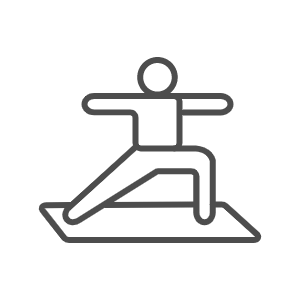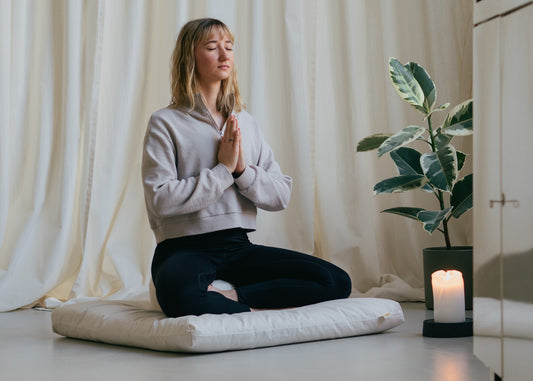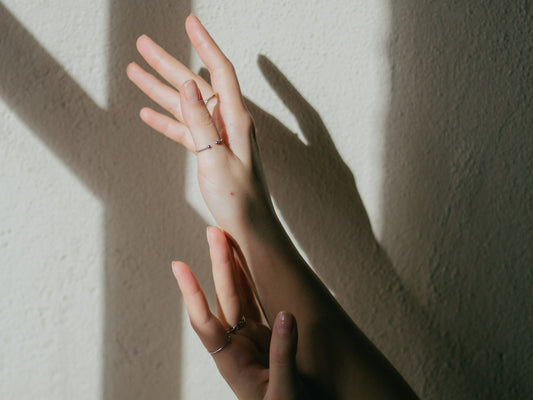
NEW In!
PURE-Matte Light TaupeShopping cart
Your shopping basket is empty
Free shipping from €39
Produced Ecologically & Fair
For All Yoga Styles
Yoga

Meditation
Sets & Bundles

If you look at the origins of mudras, you come across religion and dance – both of which are increasingly being examined by modern medicine for their healing potential.
Buddha statues or Indian deities are often depicted with certain hand or finger positions, with so-called mudras.
Mudras are, among other things, a part of yoga, but Eastern health teachings also assume that we can achieve a positive effect on our body system, our emotional and mental health with such hand gestures. According to neuroanatomy, our hands have a disproportionately large area in the brain, ie every sensory impression of the hands is in direct contact with our brain. Most people are now familiar with the foot reflex zones, but our hands also have a large number of healing points that can be stimulated. These points are also activated when holding mudras and work in the body.
The term mudra means ''seal'' in the ancient Indian language Sanskrit and means a powerful and healthy inward orientation of our thinking and feeling sealed by the respective yoga posture. There are energy-directing hand and body postures in Kundalini Yoga, with the help of which the prana (life energy) is concentrated and stored in certain body regions. Your body is a continuous sensitive receiver of energies - it receives them and transmits them on. Mudras are hand postures that trap mental energy in specific channels. They serve as a powerful spiritual tool that can help you cleanse your physical and spiritual body. Regular practice not only benefits your health, but promotes spiritual wisdom and harmony. The sacred hand postures can also release energies that are stagnant in your body and are blocking the nadis - the subtle energy pathways.
Mudras are used to keep the body healthy, to heal illnesses, but also to meditate.
The US brain researcher Richard Davidson investigated how meditation can affect the brain and had monks meditate in the MRT and was able to determine changes that persisted after the meditation. In different regions of the cerebral cortex there was a kind of common, synchronous oscillation of the brain cells. It is believed that this could be the reason why meditation gives a feeling of harmony and relaxation. Furthermore, it has been shown that the gray matter in the area of concentration thickens. Mudras that have a meditative character work in this sense and lead to more serenity in the long term. They offer you a simple and effective way of meditating when you are traveling, for example, but can intensify your regular meditation practice and lead you to deeper levels of meditation.
You activate your self-healing powers through meditation and the use of mudras and thus gain strength and alignment, remain mentally flexible and can relax at the same time.
We will now introduce you to some mudras that promote your relaxation and with which you can invite the feeling of harmony and serenity into your inner being:
Concentrating on a mudra, how to do it? First you choose a mudra that you want to include in your practice. Explore the effects of the mudra and what it is supposed to do in the body and mind. Consciously feel your hands and fingers, move them if you want and bring awareness there.
A mudra posture is always associated with a message to yourself, ie while you are practicing your mudra it is not beneficial to think about your stressful everyday life or to deal with other things.
You can focus on a positive message and mentally work with affirmations. It is therefore important to internalize the effect of the mudra very well and to work with it. Some people find it easier to enter the meditative state than others. Particularly sensitive people feel the energy and effect of the mudra directly and do not need any concentration exercises.
Others need to tune in first, which can turn into a beautiful ritual of self-care.
Shakti Mudra strengthens the respiratory impulse and gradually deepens breathing, but also helps with insomnia and has a relaxing effect. In addition, the pelvis and abdomen are relaxed.
Place the thumbs in the palms of both hands, index and middle fingers are above them. The fingertips of both ring fingers and those of the little fingers are touching.
Possible affirmations:
I rest within myself.
I release the tension from my body.
I'm totally relaxed and serene.
This is an ideal mudra when you are going through difficult times or in a situation where you need confidence eg an important conversation or an exam.
Place your hands just above your belly button in front of your solar plexus. The two index fingers are wide together, as relaxed as possible. Your thumb tips are touching and the remaining fingers are interlocked. The index fingers point away from the body while the pair of thumbs point to the chest.
Possible affirmations:
I connect with my breathing.
I am steady and focused.
I am centered and rest in my center.
Prana Mudra increases vitality and reduces fatigue and nervousness. With this mudra you take a deep breath and strengthen your life force and invite new prana, new life energy into your body.
The tips of the pinky and ring finger bend until they touch the tip of the thumb.
Possible affirmation:
So ham - I am.
I let new prana flow through me
Namaste Mudra, also called Atmanjali or Anjali, is probably the most well-known mudra from the world of yoga. Namaste means ''worship'' in Sanskrit and it helps us to focus and find balance as in prayer.
By holding our palms together we bring our right and left brain hemispheres into harmony. The Namaste greeting represents reverence to all beings in the universe - all beings, all people, creation itself.
Possible affirmations:
I am thankful for life.
I recognize the light in other beings, the same light is in me.
I honor the divine in all beings.
Gyan Mudra is a seal of knowledge and has been practiced in meditation for thousands of years. Above all, the mudra strengthens mental strength and ensures that you gain mental clarity when you feel scattered and overwhelmed by emotions.
Bring the tips of the thumb and forefinger of one hand together so they touch in a relaxed manner. The remaining 3 fingers are held loosely but are stretched. Your arms rest relaxed on your thighs.
You can also bend your index finger in front of your thumb here, meaning that the fingertips do not touch directly, but the index finger sits a little below the tip of the thumb. This symbolically stands for the fact that our ego (mind - index finger) humbly bows before the divine (thumb) and with this hand position we cultivate a mental attitude of non-identification with our mental or emotional impulses.
Possible affirmation
I am perfectly clear and focused.
I am calm.
i am focused
The Heart - Gyan is an extension of the Gyan - Mudra, which gives inner balance and helps you to open yourself to what you already have in you in terms of inner peace and contentment.
The expanded gyan mudra is also considered to be the bringer of wisdom, as the Buddha is said to have been in this posture when he attained enlightenment. The mudra promotes your ability to devote and supports your mental powers.
To do this, first sit in your preferred meditation position and form the mudra with your right hand. Now bring your right hand to the level of your heart and turn your hand so that the palm is facing inwards, upwards or outwards. The left hand rests on the inside of the left knee and also forms Gyan - Mudra with the fingers pointing downwards. The left hand symbolizes connection with the earth: the palm open to whatever love and care you are given, with the fingers pointing down to the earth and pointing to what sustains you in your foundation in life. With your right hand raised, try to feel your already existing contentment and love, also develop love for yourself and your being here. Connect to yourself, to your heart space and explore your inner heart landscape.
Possible affirmations:
i am full of love
I am provided with everything I need.
I open myself to life.


" When one enters stillness through deep meditation, the whole outer world recedes and difficulties diminish. One enjoys supreme peace'' - Swami S...
Continue reading
Dear person, maybe you have often had the feeling in your life that you are so completely different from other people, you feel that you need much...
Continue reading